Sixian Wang
Diffusion Sampling Path Tells More: An Efficient Plug-and-Play Strategy for Sample Filtering
May 29, 2025Abstract:Diffusion models often exhibit inconsistent sample quality due to stochastic variations inherent in their sampling trajectories. Although training-based fine-tuning (e.g. DDPO [1]) and inference-time alignment techniques[2] aim to improve sample fidelity, they typically necessitate full denoising processes and external reward signals. This incurs substantial computational costs, hindering their broader applicability. In this work, we unveil an intriguing phenomenon: a previously unobserved yet exploitable link between sample quality and characteristics of the denoising trajectory during classifier-free guidance (CFG). Specifically, we identify a strong correlation between high-density regions of the sample distribution and the Accumulated Score Differences (ASD)--the cumulative divergence between conditional and unconditional scores. Leveraging this insight, we introduce CFG-Rejection, an efficient, plug-and-play strategy that filters low-quality samples at an early stage of the denoising process, crucially without requiring external reward signals or model retraining. Importantly, our approach necessitates no modifications to model architectures or sampling schedules and maintains full compatibility with existing diffusion frameworks. We validate the effectiveness of CFG-Rejection in image generation through extensive experiments, demonstrating marked improvements on human preference scores (HPSv2, PickScore) and challenging benchmarks (GenEval, DPG-Bench). We anticipate that CFG-Rejection will offer significant advantages for diverse generative modalities beyond images, paving the way for more efficient and reliable high-quality sample generation.
NeRFCom: Feature Transform Coding Meets Neural Radiance Field for Free-View 3D Scene Semantic Transmission
Feb 27, 2025Abstract:We introduce NeRFCom, a novel communication system designed for end-to-end 3D scene transmission. Compared to traditional systems relying on handcrafted NeRF semantic feature decomposition for compression and well-adaptive channel coding for transmission error correction, our NeRFCom employs a nonlinear transform and learned probabilistic models, enabling flexible variable-rate joint source-channel coding and efficient bandwidth allocation aligned with the NeRF semantic feature's different contribution to the 3D scene synthesis fidelity. Experimental results demonstrate that NeRFCom achieves free-view 3D scene efficient transmission while maintaining robustness under adverse channel conditions.
Rate-Distortion-Perception Controllable Joint Source-Channel Coding for High-Fidelity Generative Communications
Aug 26, 2024Abstract:End-to-end image transmission has recently become a crucial trend in intelligent wireless communications, driven by the increasing demand for high bandwidth efficiency. However, existing methods primarily optimize the trade-off between bandwidth cost and objective distortion, often failing to deliver visually pleasing results aligned with human perception. In this paper, we propose a novel rate-distortion-perception (RDP) jointly optimized joint source-channel coding (JSCC) framework to enhance perception quality in human communications. Our RDP-JSCC framework integrates a flexible plug-in conditional Generative Adversarial Networks (GANs) to provide detailed and realistic image reconstructions at the receiver, overcoming the limitations of traditional rate-distortion optimized solutions that typically produce blurry or poorly textured images. Based on this framework, we introduce a distortion-perception controllable transmission (DPCT) model, which addresses the variation in the perception-distortion trade-off. DPCT uses a lightweight spatial realism embedding module (SREM) to condition the generator on a realism map, enabling the customization of appearance realism for each image region at the receiver from a single transmission. Furthermore, for scenarios with scarce bandwidth, we propose an interest-oriented content-controllable transmission (CCT) model. CCT prioritizes the transmission of regions that attract user attention and generates other regions from an instance label map, ensuring both content consistency and appearance realism for all regions while proportionally reducing channel bandwidth costs. Comprehensive experiments demonstrate the superiority of our RDP-optimized image transmission framework over state-of-the-art engineered image transmission systems and advanced perceptual methods.
DiffCom: Channel Received Signal is a Natural Condition to Guide Diffusion Posterior Sampling
Jun 11, 2024



Abstract:End-to-end visual communication systems typically optimize a trade-off between channel bandwidth costs and signal-level distortion metrics. However, under challenging physical conditions, this traditional discriminative communication paradigm often results in unrealistic reconstructions with perceptible blurring and aliasing artifacts, despite the inclusion of perceptual or adversarial losses for optimizing. This issue primarily stems from the receiver's limited knowledge about the underlying data manifold and the use of deterministic decoding mechanisms. To address these limitations, this paper introduces DiffCom, a novel end-to-end generative communication paradigm that utilizes off-the-shelf generative priors and probabilistic diffusion models for decoding, thereby improving perceptual quality without heavily relying on bandwidth costs and received signal quality. Unlike traditional systems that rely on deterministic decoders optimized solely for distortion metrics, our DiffCom leverages raw channel-received signal as a fine-grained condition to guide stochastic posterior sampling. Our approach ensures that reconstructions remain on the manifold of real data with a novel confirming constraint, enhancing the robustness and reliability of the generated outcomes. Furthermore, DiffCom incorporates a blind posterior sampling technique to address scenarios with unknown forward transmission characteristics. Extensive experimental validations demonstrate that DiffCom not only produces realistic reconstructions with details faithful to the original data but also achieves superior robustness against diverse wireless transmission degradations. Collectively, these advancements establish DiffCom as a new benchmark in designing generative communication systems that offer enhanced robustness and generalization superiorities.
Deep Generative Modeling Reshapes Compression and Transmission: From Efficiency to Resiliency
Jun 10, 2024



Abstract:Information theory and machine learning are inextricably linked and have even been referred to as "two sides of the same coin". One particularly elegant connection is the essential equivalence between probabilistic generative modeling and data compression or transmission. In this article, we reveal the dual-functionality of deep generative models that reshapes both data compression for efficiency and transmission error concealment for resiliency. We present how the contextual predictive capabilities of powerful generative models can be well positioned to be strong compressors and estimators. In this sense, we advocate for viewing the deep generative modeling problem through the lens of end-to-end communications, and evaluate the compression and error restoration capabilities of foundation generative models. We show that the kernel of many large generative models is powerful predictor that can capture complex relationships among semantic latent variables, and the communication viewpoints provide novel insights into semantic feature tokenization, contextual learning, and usage of deep generative models. In summary, our article highlights the essential connections of generative AI to source and channel coding techniques, and motivates researchers to make further explorations in this emerging topic.
SwinJSCC: Taming Swin Transformer for Deep Joint Source-Channel Coding
Aug 18, 2023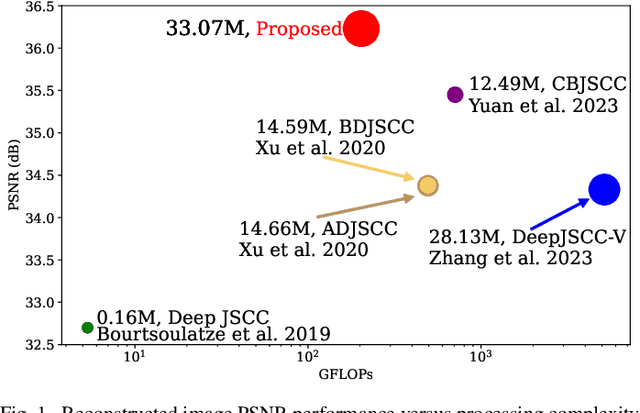

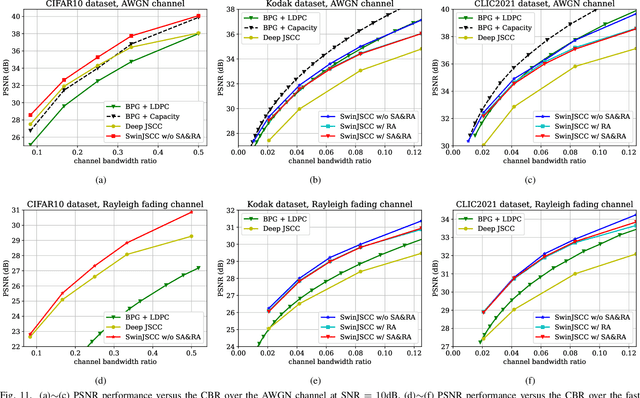

Abstract:As one of the key techniques to realize semantic communications, end-to-end optimized neural joint source-channel coding (JSCC) has made great progress over the past few years. A general trend in many recent works pushing the model adaptability or the application diversity of neural JSCC is based on the convolutional neural network (CNN) backbone, whose model capacity is yet limited, inherently leading to inferior system coding gain against traditional coded transmission systems. In this paper, we establish a new neural JSCC backbone that can also adapt flexibly to diverse channel conditions and transmission rates within a single model, our open-source project aims to promote the research in this field. Specifically, we show that with elaborate design, neural JSCC codec built on the emerging Swin Transformer backbone achieves superior performance than conventional neural JSCC codecs built upon CNN, while also requiring lower end-to-end processing latency. Paired with two spatial modulation modules that scale latent representations based on the channel state information and target transmission rate, our baseline SwinJSCC can further upgrade to a versatile version, which increases its capability to adapt to diverse channel conditions and rate configurations. Extensive experimental results show that our SwinJSCC achieves better or comparable performance versus the state-of-the-art engineered BPG + 5G LDPC coded transmission system with much faster end-to-end coding speed, especially for high-resolution images, in which case traditional CNN-based JSCC yet falls behind due to its limited model capacity. \emph{Our open-source code and model are available at \href{https://github.com/semcomm/SwinJSCC}{https://github.com/semcomm/SwinJSCC}.}
Improved Nonlinear Transform Source-Channel Coding to Catalyze Semantic Communications
Mar 26, 2023
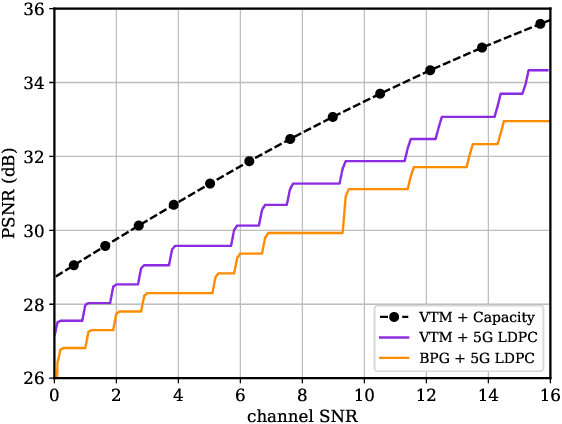
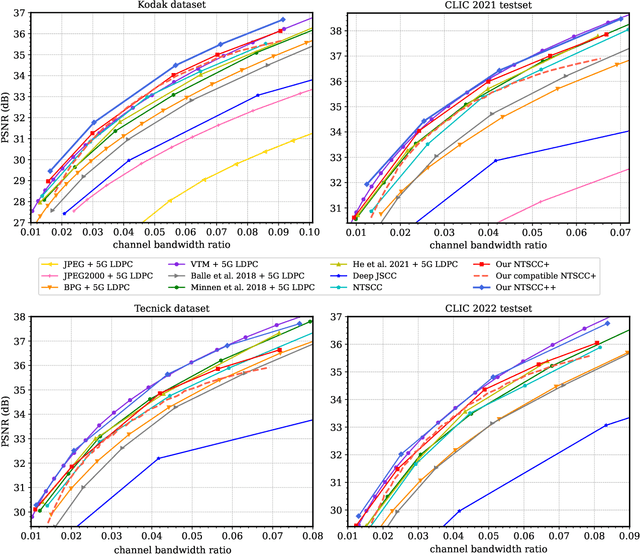

Abstract:Recent deep learning methods have led to increased interest in solving high-efficiency end-to-end transmission problems. These methods, we call nonlinear transform source-channel coding (NTSCC), extract the semantic latent features of source signal, and learn entropy model to guide the joint source-channel coding with variable rate to transmit latent features over wireless channels. In this paper, we propose a comprehensive framework for improving NTSCC, thereby higher system coding gain, better model versatility, and more flexible adaptation strategy aligned with semantic guidance are all achieved. This new sophisticated NTSCC model is now ready to support large-size data interaction in emerging XR, which catalyzes the application of semantic communications. Specifically, we propose three useful improvement approaches. First, we introduce a contextual entropy model to better capture the spatial correlations among the semantic latent features, thereby more accurate rate allocation and contextual joint source-channel coding are developed accordingly to enable higher coding gain. On that basis, we further propose response network architectures to formulate versatile NTSCC, i.e., once-trained model supports various rates and channel states that benefits the practical deployment. Following this, we propose an online latent feature editing method to enable more flexible coding rate control aligned with some specific semantic guidance. By comprehensively applying the above three improvement methods for NTSCC, a deployment-friendly semantic coded transmission system stands out finally. Our improved NTSCC system has been experimentally verified to achieve 16.35% channel bandwidth saving versus the state-of-the-art engineered VTM + 5G LDPC coded transmission system with lower processing latency.
Dimensions of Semantic Coding: Explicit and Implicit
Mar 26, 2023



Abstract:Recent advances in deep learning have led to increased interest in solving high-efficiency end-to-end transmission problems using methods that employ the nonlinear property of neural networks. These methods, we call semantic coding, extract semantic features of the source signal across space and time, and design source-channel coding methods to transmit these features over wireless channels. Rapid progress has led to numerous research papers, but a consolidation of the discovered knowledge has not yet emerged. In this article, we gather ideas to categorize the expansive aspects on semantic coding as two paradigms, i.e., explicit and implicit semantic coding. We first focus on those two paradigms of semantic coding by identifying their common and different components in building semantic communication systems. We then focus on the applications of semantic coding to different transmission tasks. Our article highlights the improved quality, flexibility, and capability brought by semantic coded transmission. Finally, we point out future directions.
Variational Speech Waveform Compression to Catalyze Semantic Communications
Dec 13, 2022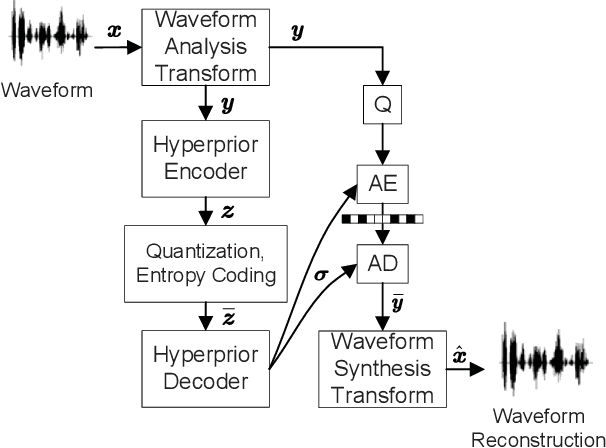
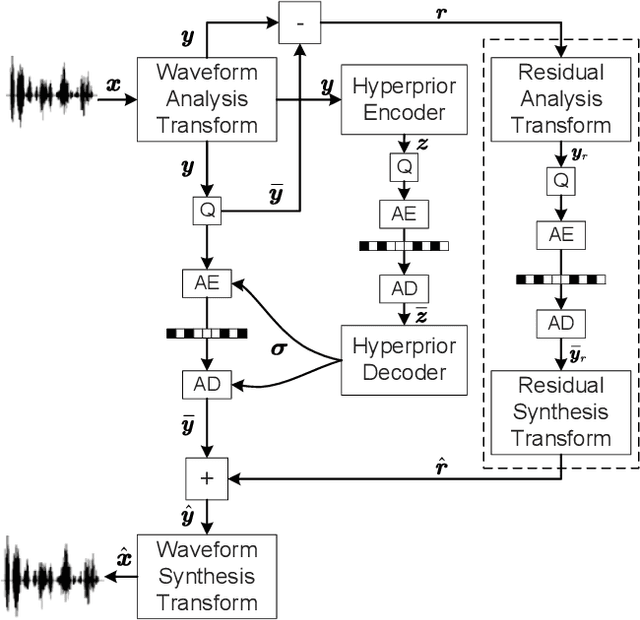
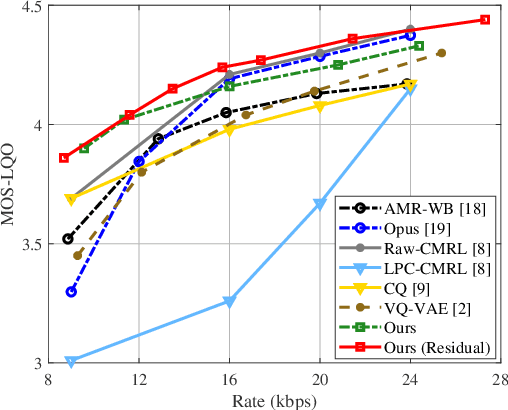
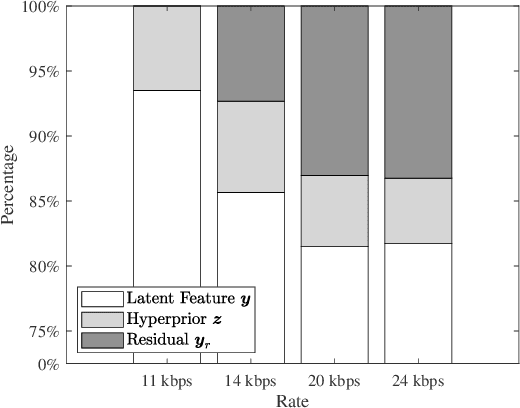
Abstract:We propose a novel neural waveform compression method to catalyze emerging speech semantic communications. By introducing nonlinear transform and variational modeling, we effectively capture the dependencies within speech frames and estimate the probabilistic distribution of the speech feature more accurately, giving rise to better compression performance. In particular, the speech signals are analyzed and synthesized by a pair of nonlinear transforms, yielding latent features. An entropy model with hyperprior is built to capture the probabilistic distribution of latent features, followed with quantization and entropy coding. The proposed waveform codec can be optimized flexibly towards arbitrary rate, and the other appealing feature is that it can be easily optimized for any differentiable loss function, including perceptual loss used in semantic communications. To further improve the fidelity, we incorporate residual coding to mitigate the degradation arising from quantization distortion at the latent space. Results indicate that achieving the same performance, the proposed method saves up to 27% coding rate than widely used adaptive multi-rate wideband (AMR-WB) codec as well as emerging neural waveform coding methods.
Adaptive Semantic Communications: Overfitting the Source and Channel for Profit
Nov 08, 2022Abstract:Most semantic communication systems leverage deep learning models to provide end-to-end transmission performance surpassing the established source and channel coding approaches. While, so far, research has mainly focused on architecture and model improvements, but such a model trained over a full dataset and ergodic channel responses is unlikely to be optimal for every test instance. Due to limitations on the model capacity and imperfect optimization and generalization, such learned models will be suboptimal especially when the testing data distribution or channel response is different from that in the training phase, as is likely to be the case in practice. To tackle this, in this paper, we propose a novel semantic communication paradigm by leveraging the deep learning model's overfitting property. Our model can for instance be updated after deployment, which can further lead to substantial gains in terms of the transmission rate-distortion (RD) performance. This new system is named adaptive semantic communication (ASC). In our ASC system, the ingredients of wireless transmitted stream include both the semantic representations of source data and the adapted decoder model parameters. Specifically, we take the overfitting concept to the extreme, proposing a series of ingenious methods to adapt the semantic codec or representations to an individual data or channel state instance. The whole ASC system design is formulated as an optimization problem whose goal is to minimize the loss function that is a tripartite tradeoff among the data rate, model rate, and distortion terms. The experiments (including user study) verify the effectiveness and efficiency of our ASC system. Notably, the substantial gain of our overfitted coding paradigm can catalyze semantic communication upgrading to a new era.
 Add to Chrome
Add to Chrome Add to Firefox
Add to Firefox Add to Edge
Add to Edge